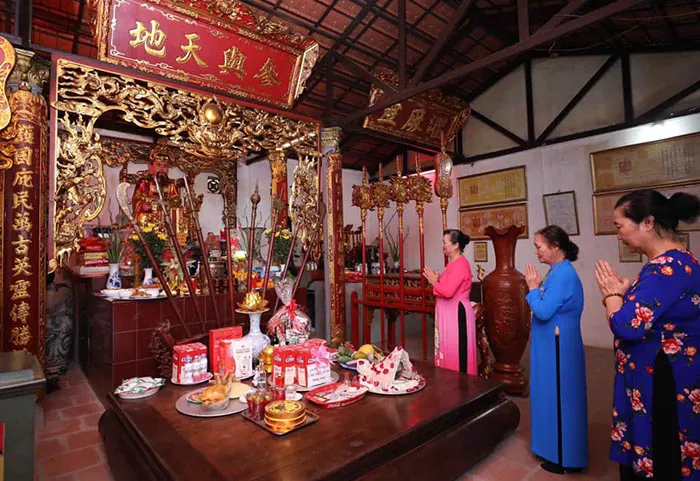Hanoi’s ancient folk heritage to be restored
Cultural and historical experts are making efforts to restore nghe (shrine) Dang Dong in Hanoi, an ancient folk relic.
Dang Dong Shrine (Thach Ban District, Long Bien District, Hanoi) is defined as a popular cultural heritage identified with the rural life of the capital. However, it is falling into oblivion and deteriorating.
| The Shrine Dang Dong is a familiar place of worship for the people in ancient Cu Linh village, Thach Ban nowadays in Hanoi. Photo: Kinh te & Do thi |
Archeologists, historians, and ethnologists have recently worked with the local people to discuss the plan to restore it.
Vestige of the relic
Secluded deep in a neighborhood in Co Linh Street, shrine Dang Dong is a familiar place of worship for locals. It used to be dedicated to the worship of a genie of Cu Linh village (renamed as Thach Ban from 1955).
Today, the Dang Dong Shrine is surrounded by fallow fields, ponds and lakes. When the ancient architecture nearly collapsed, the locals erected a makeshift structure as a place of worship.
The ancient relic is left forgotten by cultural researchers, according to Professor Tran Lam Bien, a local cultural expert. In fact, there have been many seminars to discuss the reconstruction of communal houses, pagodas, and temples but nghe or shrine is of little known and paid little attention.
| The sitting tug-of-war is recognized as a world heritage by UNESCO has to do with shrine Dang Dong. Photo: Nguoiduatin.vn |
Nghe or shrine used to play an important role in the cultural and religious life of the local people because it is the place to worship the supreme deity of a village, according to professor Bien.
Although the structure of nghe Dang Dong collapsed, it is still one of the three nghe – shrines of Cu Linh village. Moreover, it is a typical relic of the country’s resistance wars, according to historian Le Van Lan.
From the end of the 19th century until the August Revolution of 1945 and in the wars against France, nghe Dang Dong was where the patriots took refuge. Therefore, it is qualified to be classified as the typical revolutionary war relic.
Keeping the village spirit for the city
According to Dr. Bui The Quan, Deputy Head of Culture and Information Department of Long Bien District, the locals look forward to rebuilding nghe Dang Dong as a way to make cultural life thrive.
It is the fact that Vietnam’s countryside is changing strongly in the process of urbanization today. All the ancient villages and communes are now urbanized. That’s way, the folk spirit needs to be kept as well as the preservation of rural heritages such as temples, pagodas and folk games.
| The sitting tug-of-war is now replaying in Tran Vu Temple, Thach Ban Ward, Thach Ban District, Long Bien District, Hanoi. Photo: Nguoiduatin.vn |
The sitting tug-of-war in Tran Vu Temple, also in Thach Ban Ward, recognized as a world heritage by UNESCO has to do with nghe Dang Dong. It used to be held every year in March of the lunar calendar in nghe Dang Dong. But since the shrine collapsed, its celebration was moved to nearby Tran Vu Temple, according to the elders in the village.
In fact, the residents still keep in mind nghe Dang Dong’s foundation, scale, and architecture. Apart from worshiping the God Linh Hue Dai Vuonge, other religious items for worship are still kept at the place. The God is now venerated in nearby Tran Vu temple.
“Based on what we have in the place at the moment and in the memory of the local people, scientists can totally restore a full foundation, scale and architecture of nghe Dang Dong”, Dr. Nguyen Duc Nhue, Deputy Director of the Institute of History affirmed.
The local authority also said that they would consult with cultural experts to complete documents and submit to higher-level agencies for the restoration proposal of nghe Dang Dong in the coming time.













